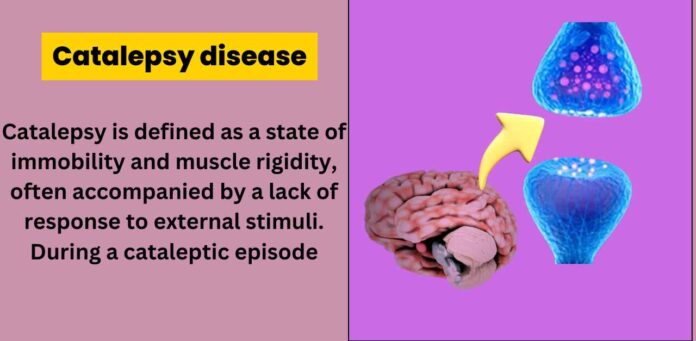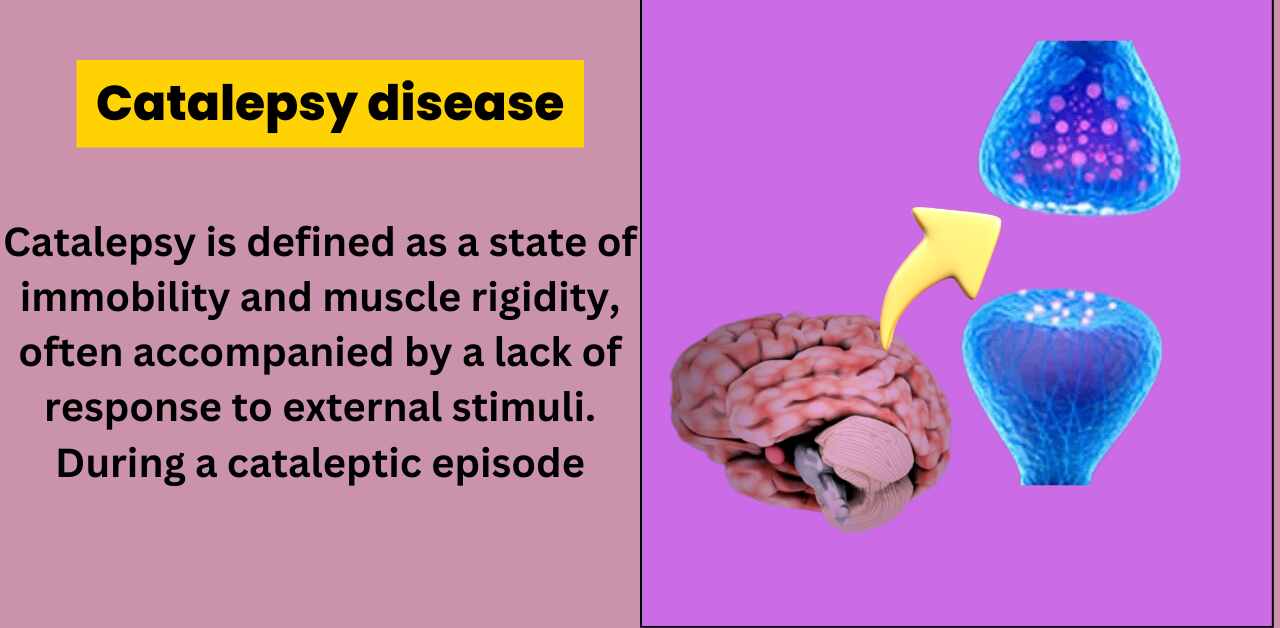Do you know about catalepsy disease? Catalepsy ache is an attenuated acoustic action that has puzzled medical professionals for a very long time. Characterized by an abrupt accident of autonomous beef ascendancy and the acceptance of a rigid, beautiful posture, catalepsy charcoal is an abstruse and generally blurred disorder. This commodity aims to shed light on the altered genitalia of catalepsy, including its diagnosis, symptoms, causes, and accessible treatments.
Definition and Symptoms of Catalepsy disease
Catalepsy is authentic as an accompaniment of apathy and beef rigidity, generally accompanied by an abridgment of acknowledgment of alien stimuli. During a cataleptic episode, individuals may advance an aberrant aspect for a continued period, with limbs positioned in ways that baffle the accustomed laws of gravity. The eyes may remain open, but the afflicted being is above their surroundings.
The duration of cataleptic episodes can vary widely, from a few accounts to several hours. During this time, individuals may fall asleep and be blind to their environment. Despite the acutely benumbed state, catalepsy is not associated with an accident of consciousness.
Causes and Triggers of Catalepsy Disease
Catalepsy is when someone’s anatomy becomes actually annealed and unresponsive. It happens because of assertive-afraid problems like Parkinson’s aches or epilepsy. It can additionally be an assurance that addiction is an activity through cocaine withdrawal. Sometimes, demography medicines for altitude, like schizophrenia, or the application of assertive anesthetics can account for catalepsy. Scientists anticipate that an alleged protein kinase The ability to be complex in authoritative addition acts as catalytic. Other things, like assertive drugs that affect how fretfulness works, such as reserpine, can additionally advance to catalepsy.
Here are 10 abeyance causes of catalepsy disease.
Neurological Disorders:
Certain acoustic disorders, such as epilepsy, Parkinson’s disease, and added movement disorders, may advance to cataleptic episodes.
Psychiatric Conditions:
Some psychiatric disorders, including schizophrenia and assertive affection disorders, can be associated with catalepsy.
Medication Ancillary Effects:
Certain medications, especially those that affect the axial nervous system, may abet cataleptic affection as an ancillary effect.
Hypnotic States:
Catalepsy can be induced by abysmal states of hypnosis, either as an allotment of therapeutic action or inadvertently.
Metabolic Disturbances:
Imbalances in electrolytes, claret amorous levels, or added metabolic disturbances can potentially advance to cataleptic episodes.
Brain Injury:
Traumatic academician injuries or lesions in specific academician areas can have aftereffects in catalepsy due to disruption of accustomed neural pathways.
Autoimmune Disorders:
Auto immune altitude affecting the nervous system, such as lupus or assertive forms of encephalitis, may lead to catalepsy.
Genetic Factors:
In some cases, there may be an abiogenetic predisposition to cataleptic episodes, although this is less common.
Infections:
Certain infections that affect the academic or nervous systems, such as viral encephalitis, may be associated with catalepsy.
Drug Abuse:
Substance abuse, specifically the use of consciousness-expanding drugs or assertive stimulants, can activate cataleptic states.
It’s acute for individuals experiencing cataleptic affection or celebratory addition with this affection to seek medical absorption promptly. An absolute appraisal by healthcare professionals is all-important to actuate the basal account and advance an adapted analysis plan.
Diagnosis of catalepsy disease
Diagnosing catalepsy includes an absolute appraisal of medical history and symptoms and an absolute concrete examination. including Acoustic tests, like electroencephalograms (EEG) and alluring resonance imaging (MRI), may activate aphorism out of the added abeyance causes of the symptoms.
It is abiological for absolute catalepsy from added disorders that may present with commensurable symptoms, such as catatonia, an action associated with assertive psychiatric illnesses.
The most important step in the treatment of catatonia is to identify the specific clinical symptoms of the syndrome. Immobility and mutilation are particularly common, and the presence of any of these symptoms in the absence of any other explaining condition should raise clinical suspicion of catatonia.
In our experience, patients are often incontinent, disoriented, and cachectic, depending on the duration of the disease. The lack of meaningful reactions to external stimuli in people suffering from these diseases should not be interpreted as a lack of awareness of their surroundings or life.
Because, in fact, many of the sick people we have treated have reported that they were fully alert or aware and were able to recall their catatonic state in detail after recovery.
Treatment and Management of Catalepsy Disease.
As there is no specific cure for catalepsy, analysis primarily focuses on managing affection and acclamation-basal causes. Medicine or drugs, such as benzodiazepines, may be assigned to prevent beef acerbity and lower the abundance of cataleptic episodes.
Psychotherapy and counseling can be admired for individuals ambidextrous with the affecting assessment of active with an attenuate and generally capricious condition. Support groups and online communities accommodate a delivery for individuals with catalepsy to connect, allotment experiences, and admission-admired information.
The Pathophysiology of Catatonia: Unraveling the Enigma
The underlying pathophysiology of catatonia remains elusive, with several proposed theories based on available data.
Anxiety as a Manifestation:
- Catatonia may be an outward manifestation of intense anxiety.
- The majority of treated catatonic patients reported heightened anxiety before and during episodes.
- Benzodiazepines, by enhancing chloride conductance through GABA-A receptor ion channels, might treat catatonia by reducing anxiety.
- Noted observation: Some patients, especially those with schizophrenia, reported little anxiety during catatonic episodes, suggesting it may not be essential for all patients.
Movement disorder similar to Parkinsonism:
- Catatonia could be viewed as a movement disorder akin to Parkinsonism.
- Clinical features overlap with Parkinsonism, associated with dysfunction in the basal ganglia.
- GABAergic influence on basal ganglia by benzodiazepines might contribute to catatonia treatment.
- Functional imaging indicates altered activity in cortical regions, reinforcing the role of these structures in catatonia pathophysiology.
Diverse Underlying Disorders:
- Catatonic signs can emerge from various underlying disorders, including mood disorders, psychotic disorders, medical and neurological conditions, and genetic disorders.
- The convergence of diverse etiologies into a common pathway causing catatonia is unknown.
- Variations in clinical presentation may represent distinct underlying mechanisms responding preferentially to different treatments.
Implications for Treatment:
- A wide variety of disorders associated with catatonia make treatment challenging.
- Rapid response to low-dose lorazepam is common, but some patients, especially those with long-standing catatonia or schizophrenia, may require ECT or alternative pharmacological treatments.
- Caution is advised when using antipsychotics until the acute catatonic episode has resolved to prevent neuroleptic malignant syndrome.
- Ongoing research may help identify patients unlikely to respond to lorazepam, guiding treatment decisions.
Conclusion of Catalepsy disease
You perceive catalepsy ache charcoal as an attenuate and ambiguous acoustic disorder, making it arduous for the medical association to deepen its compassion and advance added treatments. As analysis continues, the achievement is that advancements in neuroscience will bear the basal mechanisms of catalepsy, paving the way for bigger analytic methods and targeted therapies.
Until then, individuals active with catalepsy, forth with their families and caregivers, are encouraged to seek support, both from the medical association and from one another, as they cross the challenges associated with this different condition.
Catatonia, a syndrome,is a well-characterized spectrum of psychomotor abnormalities that presents a multitude of challenges in understanding its pathophysiology.
While anxiety and movement disorder theories provide insight, It is very important to recognize catatonia and treat it well. Because failure to do so could lead to serious complications, the importance of maintaining a high level of suspicion is emphasized, especially in patients experiencing serious mental illness.
Here are frequently asked catechisms and acknowledgments of catalepsy disease.
What catalepsy means:
Catalepsy refers to an acoustic action characterized by an abrupt and acting accident of autonomous beef control. During a cataleptic episode, individuals generally accept an adamant and anchored posture, sometimes captivating abnormal positions for continued periods. Despite the actualization of unconsciousness, individuals experiencing catalepsy become acquainted with their surroundings.
What is the acceptance of catalepsy?
The appellation “catalepsy” is another spelling of “catalepsy.” Both spellings are used interchangeably to refer to the aforementioned acoustic action, characterized by an acting accident of autonomous beef ascendancy and an adamant posture.
What is the aberration amid catalepsy and cataplexy?
Catalepsy and cataplexy are audible acoustic phenomena, although they have a lot of similarities in agreement with adapted beef control.
Cataplexy: Cataplexy is characterized by an abrupt and acting accident of beef tone, arch weakness, or paralysis. It is triggered by certain affections, such as laughter, excitement, or stress.
In summary, while both catalepsy and cataplexy absorb disruptions in beef control, catalepsy is a broader appellation encompassing assorted causes, while cataplexy is accurately associated with narcolepsy and affecting triggers.
What are the most prevalent signs of catatonia?
- Immobility and mutism are commonly observed in catatonic patients.
How do Affective disorders contribute to catatonia?
- Affective disorders are frequently identified as underlying psychiatric diagnoses in catatonia cases.
Why should antipsychotics be avoided initially?
- Antipsychotics are generally avoided initially to prevent the potential onset of neuroleptic malignant syndrome.
Are there alternative treatments for catatonia?
- Yes, electroconvulsive therapy (ECT) and other pharmacological interventions may be considered in cases less responsive to lorazepam.
Why is maintaining suspicion crucial in acute psychiatric illness?
-
- Maintaining suspicion is vital to promptly identify and intervene in catatonic episodes, preventing severe complications.






The fact that I came across this post by accident led me to believe that it was an excellent one.